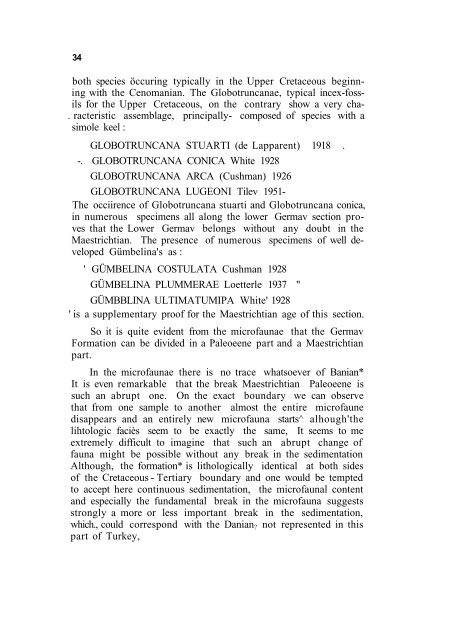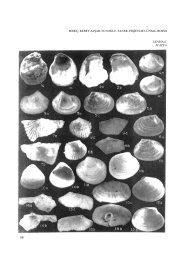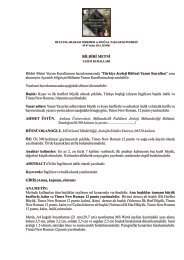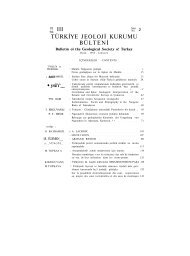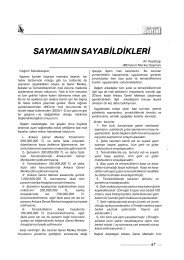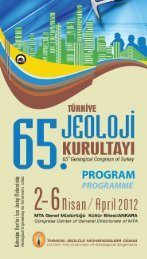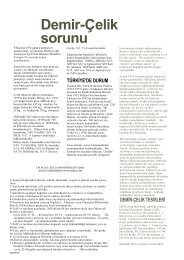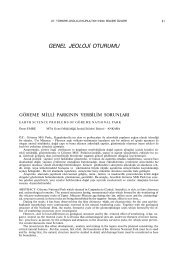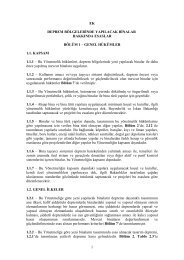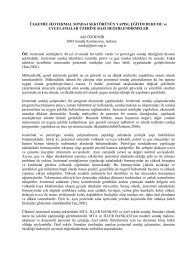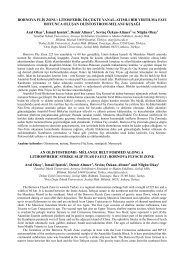Cenub DoÄu Türkiye'de Tersiyer-Kretase'Hududu
Cenub DoÄu Türkiye'de Tersiyer-Kretase'Hududu
Cenub DoÄu Türkiye'de Tersiyer-Kretase'Hududu
You also want an ePaper? Increase the reach of your titles
YUMPU automatically turns print PDFs into web optimized ePapers that Google loves.
34<br />
both species öccuring typically in the Upper Cretaceous beginning<br />
with the Cenomanian. The Globotruncanae, typical incex-fossils<br />
for the Upper Cretaceous, on the contrary show a very cha-<br />
. racteristic assemblage, principally- composed of species with a<br />
simole keel :<br />
GLOBOTRUNCANA STUARTI (de Lapparent) 1918 .<br />
-. GLOBOTRUNCANA CONICA White 1928<br />
GLOBOTRUNCANA ARCA (Cushman) 1926<br />
GLOBOTRUNCANA LUGEONI Tilev 1951-<br />
The occiirence of Globotruncana stuarti and Globotruncana conica,<br />
in numerous specimens all along the lower Germav section proves<br />
that the Lower Germav belongs without any doubt in the<br />
Maestrichtian. The presence of numerous specimens of well developed<br />
Gümbelina's as :<br />
' GÜMBELINA COSTULATA Cushman 1928<br />
GÜMBELINA PLUMMERAE Loetterle 1937 "<br />
GÜMBBLINA ULTIMATUMIPA White' 1928<br />
' is a supplementary proof for the Maestrichtian age of this section.<br />
So it is quite evident from the microfaunae that the Germav<br />
Formation can be divided in a Paleoeene part and a Maestrichtian<br />
part.<br />
In the microfaunae there is no trace whatsoever of Banian*<br />
It is even remarkable that the break Maestrichtian Paleoeene is<br />
such an abrupt one. On the exact boundary we can observe<br />
that from one sample to another almost the entire microfaune<br />
disappears and an entirely new microfauna starts^ alhough'the<br />
lihtologic faciès seem to be exactly the same, It seems to me<br />
extremely difficult to imagine that such an abrupt change of<br />
fauna might be possible without any break in the sedimentation<br />
Although, the formation* is lithologically identical at both sides<br />
of the Cretaceous - Tertiary boundary and one would be tempted<br />
to accept here continuous sedimentation, the microfaunal content<br />
and especially the fundamental break in the microfauna suggests<br />
strongly a more or less important break in the sedimentation,<br />
which., could correspond with the Danian ? not represented in this<br />
part of Turkey,


